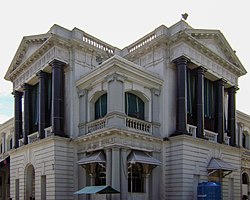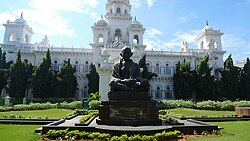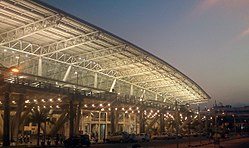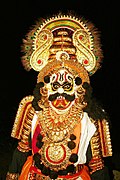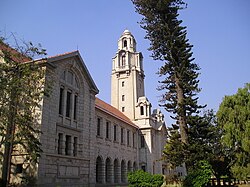Top Qs
Timeline
Chat
Perspective
South India
Region in India From Wikipedia, the free encyclopedia
Remove ads
South India, also known as Southern India or Peninsular India, is the southern part of the Deccan Peninsula in India encompassing the states of Andhra Pradesh, Karnataka, Kerala, Tamil Nadu and Telangana as well as the union territories of Lakshadweep and Puducherry, occupying 19.31% of India's area (635,780 km2 or 245,480 sq mi) and 20% of India's population. It is bound by the Bay of Bengal in the east, the Arabian Sea in the west and the Indian Ocean in the south. The geography of the region is diverse, with two mountain ranges, the Western and Eastern Ghats, bordering the plateau heartland. The Godavari, Krishna, Kaveri, Penna, Tungabhadra and Vaigai rivers are important non-perennial sources of water. Chennai, Bengaluru, Hyderabad, Coimbatore and Kochi are the largest urban areas in the region.
Remove ads
The majority of the people in South India speak at least one of the four major Dravidian languages: Telugu, Tamil, Kannada and Malayalam. During its history, a number of dynastic kingdoms ruled over parts of South India, and shaped the culture in those regions. Major dynasties that were established in South India include the Cheras, Cholas, Pandyas, Pallavas, Satavahanas, Chalukyas, Hoysalas, Rashtrakutas and Vijayanagara. European countries entered India through Kerala and the region was colonized by Britain, Portugal and France.
After experiencing fluctuations in the decades immediately after Indian independence, the economies of South Indian states have registered a sustained higher-than-national-average growth over the past three decades. South India has the largest combined largest gross domestic product compared to other regions in India. The South Indian states lead in some socio-economic metrics of India with a higher HDI as the economy has undergone growth at a faster rate than in most northern states. As of 2011, Literacy rates in the southern states is higher than the national average at approximately 76%. The fertility rate in South India is 1.9, the lowest of all regions in India.
Remove ads
Etymology
"South India" is also known as "Peninsular India" indicating its location in a peninsula surrounded by water on three sides.[4] The term "Deccan", referring to the area covered by the Deccan Plateau that covers most of peninsular India excluding the coastal areas, is an anglicised form of the Prakrit word dakkhiṇa derived from the Sanskrit word dakshiṇa meaning south.[5] Carnatic, derived from "Karnāḍ" or "Karunāḍ" meaning high country, has also been associated with South India.[6]
Remove ads
History
Summarize
Perspective
Ancient and medieval era
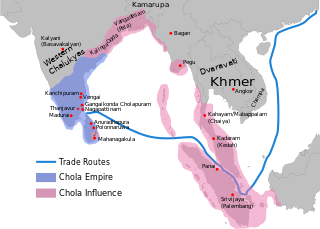
Carbon dating shows that ash mounds associated with Neolithic cultures in South India date back to 8000 BCE. Towards the beginning of 1000 BCE, iron technology spread through the region; however, there does not appear to be a fully developed Bronze Age preceding the Iron Age in South India.[7] The region was in the middle of a trade route that extended from Muziris to Arikamedu linking the Mediterranean to East Asia.[8][9] Trade with Phoenicians, Romans, Greeks, Arabs, Syrians, Jews, and Chinese began during the Sangam period (c. 3rd century BCE to c. 4th century CE).[10] The region was part of the ancient Silk Road connecting the East with the West.[11]
Several dynasties such as the Cheras of Karuvur, the Pandyas of Madurai, the Cholas of Thanjavur, the Zamorins of Kozhikode, the Satavahanas of Amaravati, the Pallavas of Kanchi, the Kadambas of Banavasi, the Western Gangas of Kolar, the Rashtrakutas of Manyakheta, the Chalukyas of Badami, the Hoysalas of Belur, and the Kakatiyas of Orugallu ruled over the region from the 6th century BCE to the 14th century CE. In the 15th century, Vijayanagara empire was the last kingdom to conquer all of Southern India.[12] After repeated invasions from the Sultanate of Delhi, the Vijayanagara empire fell in 1646 and the region was ruled by various Deccan Sultanates, polygars and Nayak governors of the erstwhile Vijayanagara empire who declared independence.[13]
Colonial era
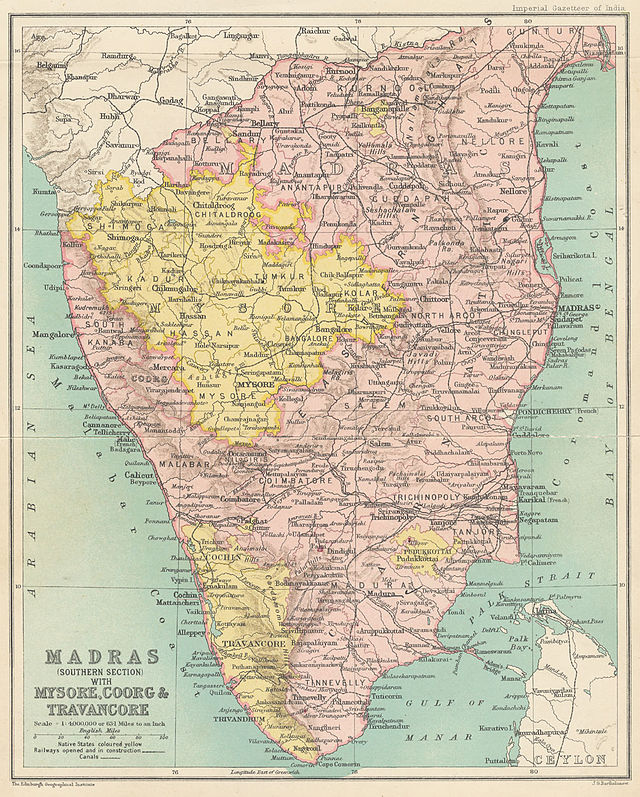
The Europeans arrived in the 15th century; and by the middle of the 18th century, the French and the British were involved in a protracted struggle for military control over South India. After the defeat of Tipu Sultan in the Fourth Anglo-Mysore War in 1799 and the end of the Vellore Mutiny in 1806, the British consolidated their power over much of present-day South India, with the exception of French Pondichéry. The British Empire took control of the region from the British East India Company in 1857.[14] During the British colonial rule, the region was divided into the Madras Presidency (later, the Madras Province), Hyderabad State, Mysore, and the Madras States Agency (composed of Travancore, Cochin, Jeypore, and a number of other minor princely states). The region played a major role in the Indian independence movement. Of the 72 delegates who participated in the first session of the Indian National Congress at Bombay in December 1885, 22 hailed from South India.[15]
Post-independence
After Indian Independence in 1947, the region was organized into four states Madras State, Mysore State, Hyderabad State and Travancore-Cochin.[16] Dravida Nadu was a proposal for a separate sovereign state for the speakers of the Dravidian languages in South India. Initially, the demand of Dravida Nadu proponents was limited to Tamil-speaking regions, but it was later expanded to include other Indian states with a majority of Dravidian-speakers in the region.[17] The States Reorganisation Act 1956, which created linguistic States, weakened the demand for a separate sovereign state.[18][19]
The States Reorganisation Act of 1956 reorganized the states based on linguistic lines resulting in the creation of the new states of Andhra Pradesh, Karnataka, Kerala and Tamil Nadu.[20][21] As a result of this act, Madras State retained its name with Kanyakumari district added to from Travancore-Cochin. The state was subsequently renamed Tamil Nadu in 1968.[22] Andhra Pradesh was created with the merger of Andhra State with the Telugu-speaking districts of Hyderabad State in 1956. Kerala was created with the merger of Malabar district and the Kasaragod taluk of South Canara districts of Madras State with Travancore-Cochin. Mysore State was re-organized with the addition of districts of Bellary and South Canara (excluding Kasaragod taluk) and the Kollegal taluk of Coimbatore district from the Madras State, the districts of Belgaum, Bijapur, North Canara and Dharwad from Bombay State, the Kannada-majority districts of Bidar, Raichur and Gulbarga from Hyderabad State and the province of Coorg.[23] Mysore State was renamed as Karnataka in 1973.[24] The Union Territory of Puducherry was created in 1954 comprising the previous French enclaves of Pondichéry, Karaikal, Yanam and Mahé.[20] The Laccadive Islands which were divided between South Canara and Malabar districts of Madras State were united and organized into the union territory of Lakshadweep.[20] Telangana was created on June 2, 2014, by bifurcating Andhra Pradesh and comprises ten districts in northwestern Andhra Pradesh.[25][26]
Remove ads
Geography
Summarize
Perspective
Topography

South India is a peninsula in the shape of an inverted triangle bound by Indian Ocean in the South, Arabian Sea in the west, by Bay of Bengal in the east and the Vindhya and Satpura ranges in the north.[27] The Narmada river flows westwards in the depression between the Vindhya and Satpura ranges, which define the northern spur of the Deccan plateau.[28] The low-lying coral islands of Lakshadweep are situated off the southwestern coast of India and the Andaman and Nicobar islands lie far off the eastern coast. The Palk Strait and the chain of low sandbars and islands known as Rama's Bridge separate the region from Sri Lanka, which lies off the southeastern coast.[29][30] The southernmost tip of mainland India is at Kanyakumari where the Indian Ocean meets the Bay of Bengal and the Arabian Sea.[31]

The Western Ghats runs south along the western coast from south of the Tapti River to Kanyakumari and forms a narrow strip of land with the Arabian sea called Konkan region.[32] Anai Mudi in the Anaimalai Hills 2,695 m (8,842 ft) is the highest peak in South India.[33] The Eastern Ghats run parallel to the Bay of Bengal along the eastern coast and the strip of land between them forms the Coromandel region.[34] They are a discontinuous range of mountains, which have been eroded and quadrisected by the four major rivers of southern India, the Godavari, Mahanadi, Krishna, and Kaveri.[35] Both mountain ranges meet at the Nilgiri mountains which run in a crescent approximately along the borders of Tamil Nadu with northern Kerala and Karnataka, encompassing the Palakkad and Wayanad hills and the Sathyamangalam ranges, extending to the relatively low-lying hills of the Eastern Ghats on the western portion of the Tamil Nadu–Andhra Pradesh border, forming the Tirupati and Annamalai hills.[36]
The Deccan plateau is the elevated region bound by the mountain ranges.[37] The plateau rises to 100 metres (330 ft) in the north and to more than 1 kilometre (0.62 mi) in the south, forming a raised triangle within the downward-pointing triangle of the Indian subcontinent's coastline.[38] It also slopes gently from West to East resulting in major rivers arising in the Western Ghats and flowing east into the Bay of Bengal.[39] The volcanic basalt beds of the Deccan were laid down in the massive Deccan Traps eruption, which occurred towards the end of the Cretaceous period, between 67 and 66 million years ago.[40] Layer after layer was formed by the volcanic activity that lasted many years and when the volcanoes became extinct, they left a region of highlands with typically vast stretches of flat areas on top like a table.[41] The plateau is watered by the east-flowing Godavari, Krishna, Kaveri, Penna, Tungabhadra, Vaigai rivers and their tributaries.[42]
Other prominent features include the Gulf of Mannar, the Palk Strait, which separates India from Sri Lanka; the Ten Degree Channel, which separates the Andamans from the Nicobar Islands; and the Eight Degree Channel, which separates the Laccadive and Amindivi Islands from the Minicoy Island to the south.[43] Laccadive Sea is a smaller sea.[44] There are coral reefs located in the Gulf of Mannar and Lakshadweep islands.[45] Large lakes include Vembanad Lake and Pulicat Lake.[46]
Climate

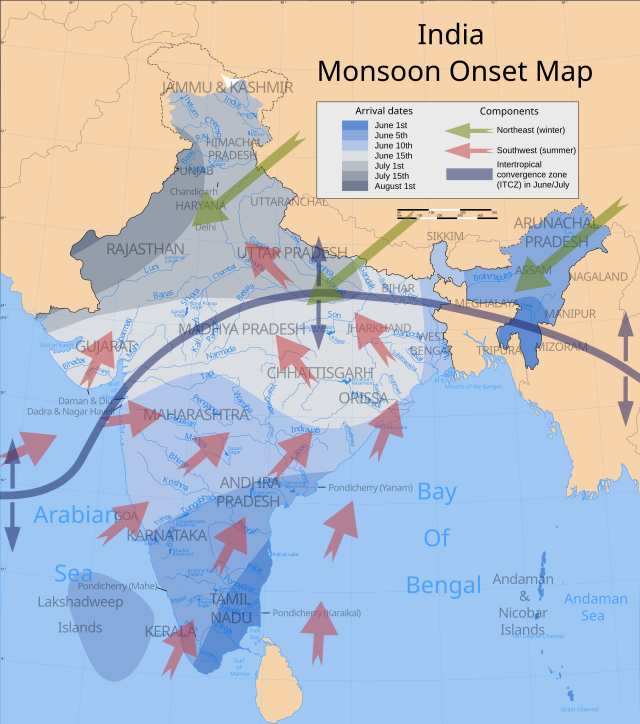
The region has a tropical climate and depends on monsoons for rainfall. According to the Köppen climate classification, it has a non-arid climate with minimum mean temperatures of 18 °C (64 °F).[47] The most humid is the tropical monsoon climate characterized by moderate to high year-round temperatures and seasonally heavy rainfall above 2,000 mm (79 in) per year. The tropical climate is experienced in a strip of south-western lowlands abutting the Malabar Coast, the Western Ghats and the Lakshadweep islands.[48]
A tropical wet and dry climate, drier than areas with a tropical monsoon climate, prevails over most of the inland peninsular region except for a semi-arid rain shadow east of the Western Ghats. Winter and early summer are long dry periods with temperatures averaging above 18 °C (64 °F); summer is exceedingly hot with temperatures in low-lying areas exceeding 50 °C (122 °F); and the rainy season lasts from June to September, with annual rainfall averaging between 750 and 1,500 mm (30 and 59 in) across the region. Once the dry northeast monsoon begins in September, most precipitation in India falls in Tamil Nadu, leaving other states comparatively dry.[49] A hot semi-arid climate predominates in the land east of the Western Ghats and the Cardamom Hills. The region – which includes Karnataka, inland Tamil Nadu and western Andhra Pradesh – gets between 400 and 750 millimetres (15.7 and 29.5 in) of rainfall annually, with hot summers and dry winters with temperatures around 20–24 °C (68–75 °F). The months between March and May are hot and dry, with mean monthly temperatures hovering around 32 °C (90 °F), with 320 millimetres (13 in) precipitation. Without artificial irrigation, this region is not suitable for agriculture.[50]
The southwest monsoon from June to September accounts for most of the rainfall in the region. The Arabian Sea branch of the southwest monsoon hits the Western Ghats along the coastal state of Kerala and moves northward along the Konkan coast, with precipitation on coastal areas west of the Western Ghats. The lofty Western Ghats prevent the winds from reaching the Deccan Plateau; hence, the leeward region (the region deprived of winds) receives very little rainfall.[51][52] The Bay of Bengal branch of the southwest monsoon heads toward northeast India, picking up moisture from the Bay of Bengal. The Coramandel coast does not receive much rainfall from the southwest monsoon, due to the shape of the land. Tamil Nadu and southeast Andhra Pradesh receive rains from the northeast monsoon.[53] The northeast monsoon takes place from November to early March, when the surface high-pressure system is strongest.[54] The North Indian Ocean tropical cyclones occur throughout the year in the Bay of Bengal and the Arabian Sea, bringing devastating winds and heavy rainfall.[55][56][57]
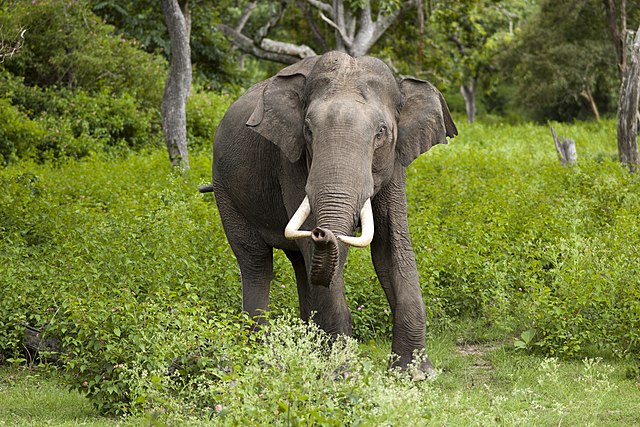

Flora and fauna
There is a wide diversity of plants and animals in South India, resulting from its varied climates and geography. Deciduous forests are found along the Western Ghats while tropical dry forests and scrub lands are common in the interior Deccan plateau. The southern Western Ghats have rain forests located at high altitudes called the South Western Ghats montane rain forests, and the Malabar Coast moist forests are found on the coastal plains.[58] The Western Ghats is one of the eight hottest biodiversity hotspots in the world and a UNESCO World Heritage Site.[59][60]
Important ecological regions of South India are the Nilgiri Biosphere Reserve in the Nilgiri Hills, the Agasthyamala Biosphere Reserve in the Agastya Mala-Cardamom Hills and Gulf of Mannar coral reefs.[61] The Gulf of Mannar Biosphere Reserve covers an area of 10,500 km2 (4,100 sq mi) of ocean, islands and the adjoining coastline including coral reefs, salt marshes and mangroves. It is home to endangered aquatic species, including dolphins, dugongs, whales and sea cucumbers.[62][63] Bird sanctuaries including Thattekad, Kadalundi, Vedanthangal, Ranganathittu, Kumarakom, Neelapattu, and Pulicat are home to numerous migratory and local birds.[64][65]
South India is home to one of the largest populations of endangered Bengal tigers and Indian elephants in India, being home to one-third of the tiger population and more than half of the elephant population,[66][67] with 14 Project Tiger reserves and 11 Project Elephant reserves.[68][69] Elephant populations are found in eight fragmented sites in the region: in northern Karnataka, along the Western Ghats, in Bhadra–Malnad, in Brahmagiri–Nilgiris–Eastern Ghats, in Nilambur–Silent Valley–Coimbatore, in Anamalai–Parambikulam, in Periyar–Srivilliputhur, and in Agasthyamalai[70] Other threatened and endangered species found in the region include the grizzled giant squirrel,[71] grey slender loris,[72] sloth bear,[73] Nilgiri tahr,[74] Nilgiri langur,[75] lion-tailed macaque,[76] and the Indian leopard.[77]
Remove ads
Politics
Summarize
Perspective
Politics in South India is characterized by a mix of regional and national political parties. The Justice Party and Swaraj Party were the two major parties in the erstwhile Madras Presidency.[86] The Justice Party eventually lost the 1937 elections to the Indian National Congress, and Chakravarti Rajagopalachari became the Chief Minister of the Madras Presidency.[86] During the 1920s and 1930s, the Self-Respect Movement, spearheaded by Theagaroya Chetty and E. V. Ramaswamy (commonly known as Periyar), emerged in the Madras Presidency.[87] In 1944, Periyar transformed the party into a social organisation, renaming the party Dravidar Kazhagam, and withdrew from electoral politics. The initial aim was the secession of Dravida Nadu from the rest of India upon Indian independence. After independence, C. N. Annadurai, a follower of Periyar, formed the Dravida Munnetra Kazhagam (DMK) in 1948. The Anti-Hindi agitations of Tamil Nadu led to the rise of Dravidian parties that formed Tamil Nadu's first government, in 1967. In 1972, a split in the DMK resulted in the formation of the All India Anna Dravida Munnetra Kazhagam (AIADMK) led by M. G. Ramachandran. Dravidian parties continue to dominate Tamil Nadu electoral politics, the national parties usually aligning as junior partners to the major Dravidian parties, AIADMK and DMK.[88][89]
Indian National Congress dominated the political scene in Tamil Nadu in the 1950s and 1960s under the leadership of K. Kamaraj, who led the party after the death of Jawaharlal Nehru and ensured the selection of Prime Ministers Lal Bahadur Shastri and Indira Gandhi.[90] Congress continues to be a major party in Telangana, Karnataka, and Kerala. The party ruled with minimal opposition for 30 years in Andhra Pradesh, before the formation of the Telugu Desam Party by Nandamuri Taraka Rama Rao in 1982.[91] Two prominent coalitions in Kerala are the United Democratic Front, led by the Indian National Congress, and the Left Democratic Front, led by the Communist Party of India (Marxist). For the past fifty years, these two coalitions have been alternately in power; and E. M. S. Namboodiripad, the first elected chief minister of Kerala in 1957, is credited as the leader of the first democratically elected communist government in the world.[92][93] The Bharatiya Janata Party and Janata Dal (Secular) are significant parties in Karnataka.[94]
C. Rajagopalachari, the first Indian Governor General of India post independence, was from South India. The region has produced six Indian presidents, namely, Sarvepalli Radhakrishnan,[95] V. V. Giri,[96] Neelam Sanjiva Reddy,[97] R. Venkataraman,[98] K. R. Narayanan,[99] and APJ Abdul Kalam.[100] Prime ministers P. V. Narasimha Rao and H. D. Deve Gowda were from the region.[101]
Administration
South India consists of the five southern Indian states of Andhra Pradesh, Telangana, Karnataka, Kerala, and Tamil Nadu, as well as the union territories of Puducherry, and Lakshadweep.[102][103] Puducherry and the five states each have an elected state government, while Lakshadweep is centrally administered by the president of India.[104][105]
Each state is headed by a Governor who is appointed by the President of India and who names the leader of the state legislature's ruling party or coalition as chief minister, who is the head of the state government.[106][107]
Each state or territory is further divided into districts, which are further subdivided into revenue divisions and taluks / Mandals or tehsils.[108] Local bodies govern respective cities, towns, and villages, along with an elected mayor, municipal chairman, or panchayat chairman, respectively.[109]
States
Union territories
Legislative representation
Legislative assemblies of states
Shasana Sabha (Andhra Pradesh)
Vidhan Soudha (Karnataka)
Niyamasabha Mandiram (Kerala)
Fort St. George (Tamil Nadu)
Shasana Sabha (Telangana)
Legislative Assembly (Puducherry)
South India elects 132 members to the Lok Sabha, accounting for roughly one-fourth of the total strength.[121] The region is allocated 58 seats in the Rajya Sabha, out of the total of 245.[122]
The state legislatures of Tamil Nadu, Kerala and Puducherry are unicameral, while Andhra Pradesh, Karnataka, and Telangana have bicameral legislatures.[123][124] States with bicameral legislatures have an upper house (Legislative Council) with members not more than one-third the size of the Assembly. State legislatures elect members for terms of five years.[109] Governors may suspend or dissolve assemblies and can administer when no party is able to form a government.[109]
Remove ads
Demographics
Summarize
Perspective
As per the 2011 census of India, the estimated population of South India was 252 million, around one fifth of the total population of the country. The region's total fertility rate (TFR) was less than the population replacement level of 2.1 for all states, with Kerala and Tamil Nadu having the lowest TFRs in India at 1.7.[125][126] As a result, from 1981 to 2011 the proportion of the population of South India to India's total population has declined.[127][128] Scheduled Castes and Tribes form 18% of the population of the region. Agriculture is the major employer in the region, with 47.5% of the population being involved in agrarian activities.[129] About 60% of the population lives in permanent housing structures.[130] 67.8% of South India has access to tap water, with wells and springs being major sources of water supply.[131]
After experiencing fluctuations in the decades immediately after the independence of India, the economies of South Indian states have, over the past three decades, registered growth higher than the national average. While South Indian states have improved in some of the socio-economic metrics,[132][133] poverty continues to affect the region as it does the rest of the country, although it has considerably decreased over the years. Based on the 2011 census, the HDI in the southern states is high, and the economy has grown at a faster rate than those of most northern states.[134]
As per the 2011 census, the average literacy rate in South India is approximately 80%, considerably higher than the Indian national average of 74%, with Kerala having the highest literacy rate of 93.91%.[116] South India has the highest sex ratio with Kerala and Tamil Nadu being the top two states.[135] The South Indian states rank amongst the top 10 in economic freedom,[136] life expectancy .,[137] access to drinking water,[138] house ownership,[139] and TV ownership[140] The poverty rate is at 19% while that in the other Indian states is at 38%. The per capita income is ₹19,531 (US$230), which is more than double of the other Indian states (₹8,951 (US$110)).[141][142] Of the three demographically related targets of the Millennium Development Goals set by the United Nations and expected to be achieved by 2015, Kerala and Tamil Nadu achieved the goals related to improvement of maternal health and of reducing infant mortality and child mortality by 2009.[143][144]
Languages
The largest linguistic group in South India is the Dravidian family of languages, of approximately 73 languages.[146] The major languages spoken include Telugu, Tamil, Kannada, and Malayalam.[147] Tulu is spoken by about 1.5 million people in coastal Kerala and Karnataka; Konkani, an Indo-Aryan language, is spoken by around 0.8 million people in the Konkan coast (Canara) and Kerala; Kodava Takk is spoken by more than half a million people in Kodagu, Mysore, and Bangalore. English is also widely spoken in urban areas of South India.[148] Deccani Urdu a regional dialect of Urdu is spoken by the Muslims.[149][150][151] Telugu, Tamil, Kannada, Malayalam, Urdu, and konkani are listed among the 22 official languages of India. Tamil was the first language to be granted classical language status by the Government of India in 2004.[152][153] Later Telugu (2008), Kannada (2008) and Malayalam (2013) were also declared as classical languages.[154][155] These four languages combined have literary outputs larger than other literary languages of India.[156]
Religion
Religion in South India (2011)[157]
- Hinduism (82.64%)
- Islam (11.57%)
- Christianity (5.11%)
- Others (0.68%)
Evidence of prehistoric religion in South India comes from scattered Mesolithic rock paintings depicting dances and rituals, such as the Kupgal petroglyphs of eastern Karnataka, at Stone Age sites.[158]
Hinduism is the major religion today in South India, with about 84% of the population adhering to it, which is often regarded as the oldest religion in the world, tracing its roots to prehistoric times in India.[159] Its spiritual traditions include both the Shaivite and Vaishnavite branches of Hinduism, although Buddhist and Jain philosophies were influential several centuries earlier.[160] Ayyavazhi has spread significantly across the southern parts of South India.[161][162] Shaiva Siddhanta philosophy is prominent among many communities.[163]
Islam was introduced to South India in the early 7th century by Arab traders on the Malabar Coast, and spread during the rule of the Deccan Sultanates, from the 17th to 18th centuries. About 11% of the population In South India follow Islam.[164] Muslims of Arab descent in Kerala are called Jonaka Mappila.[165] About 4% follow Christianity.[166] Christianity was introduced to South India by Thomas the Apostle, who visited Muziris in Kerala in 52 CE and proselytized natives, who are called Nazrani Mappila.[167][168] Kerala is also home to one of the oldest Jewish communities in the world, who are supposed to have arrived on the Malabar coast during the reign of King Solomon.[169][170]
Largest cities
The major metropolitan areas in south India are as follows:
Remove ads
Transport
Summarize
Perspective

Road
South India has an extensive road network with 20,573 km (12,783 mi) of National Highways and 46,813 km (29,088 mi) of State Highways. The Golden Quadrilateral connecting Chennai with Mumbai and Kolkata traverses Tamil Nadu, Karnataka and Andhra Pradesh.[172] Bus services are provided by state-run transport corporations, namely the Andhra Pradesh State Road Transport Corporation,[173] Tamil Nadu State Transport Corporation,[174] Karnataka State Road Transport Corporation,[175] Telangana State Road Transport Corporation,[176][177] Kerala State Road Transport Corporation,[178] and Puducherry Road Transport Corporation.[179]
Rail
In 1832, the proposal to construct the first railway line in India at Madras was made.[183][184] In 1835, a railway track was constructed between Red Hills and Chintadripet in Madras and became operational in 1837.[185] The Madras Railway was established in 1845.[184] The Great Southern of India Railway Company was founded in England in 1853 and registered in 1859.[186] The construction on the first main line in the South between Royapuram in Madras and Arcot started in 1853, which became operational on 1 July 1856.[187] Construction of track in the Madras Presidency began in 1859 and the 80 miles (130 km) link from Trichinopoly to Negapatam and a link from Tirur to the Port of Beypore at Kozhikode on the Malabar Coast, which eventually got expanded into the Mangalore-Chennai line via Palakkad Gap were opened in 1861.[188] The Carnatic Railway Company was founded in 1864 and opened a Madras–Arakkonam–Conjeevaram–Katpadi junction line in 1865. These two companies subsequently merged in 1874 to form the South Indian Railway Company.[189] In 1880, the Great Indian Peninsula Railway, established by the British, built a railway network radiating from Madras.[190] In 1879, the Madras Railway constructed a line from Royapuram to Bangalore; and the Maharaja of Mysore established the Mysore State Railway to build an extension from Bangalore to Mysore.[191] The Madras and Southern Mahratta Railway was founded on 1 January 1908 by merging the Madras Railway and the Southern Mahratta Railway.[192][193]
On 14 April 1951, the Madras and Southern Mahratta Railway, the South Indian Railway, and the Mysore State Railway were merged to form the Southern Railway, the first zone of Indian Railways.[194] The South Central zone was created on 2 October 1966 as the ninth zone of Indian Railways and the South Western zone was created on 1 April 2003.[195][196] Most of the region is covered by the three zones, with small portions of the coasts covered by East Coast Railway and Konkan Railway. In 2019, a new South Coast Railway zone was announced but is yet to become operational as of 2023.[197] The Nilgiri Mountain Railway of Southern Railway is a UNESCO World Heritage Site.[198] Indian Railways under the ownership of the Ministry of Railways of the Government of India operates the railway system.[199]
Suburban and Metro
Currently, operational metro systems are there in four cities Chennai, Bengaluru, Hyderabad and Kochi.[208][209] Chennai Suburban founded in 1928 is one of the oldest and largest urban networks in the country.[210] Opened in 1995, Chennai MRTS was the first elevated urban railway in India.[210] Hyderabad MMTS was opened in 2003, becoming the second city in South India to have a local rail transit system.[211] As of December 2022, South India has 205.06 km of operational metro lines and 16 systems.[212]
Air
In 1915, Tata Sons started a regular airmail service between Karachi and Madras marking the beginning of air transportation in the southern part of India.[220] In March 1930, a discussion initiated by pilot G. Vlasto led to the founding of the Madras Flying Club, which became a pioneer in pilot training in South India.[221][222] On 15 October 1932, Indian aviator J. R. D. Tata flew a Puss Moth aircraft carrying mail from Karachi to Juhu aerodrome, Bombay; and the aircraft continued to Madras, piloted by Neville Vincent, a former Royal Air Force pilot and friend of Tata.[223][224]
There are 12 international airports, 2 customs airports, 15 domestic airports, 5 state owned/private airports and 15 air bases in South India.[225] Bengaluru, Chennai, Hyderabad, and Kochi international airports are amongst the 10 busiest in the country.[226] Chennai International Airport serves as the Southern Regional Headquarters of the Airports Authority of India, the Southern Region comprising the states of Andhra Pradesh, Karnataka, Kerala, Tamil Nadu, and Telangana, and the union territories of Puducherry and Lakshadweep.[227] Four of the ten busiest airports in India are in South India.
The region comes under the purview of the Southern Air Command of the Indian Air Force headquartered at Thiruvananthapuram. In addition, the National Training Command is headquartered at Bengaluru. The Air Force operates nine air bases in Southern India.[228] In the region, the Indian Navy operates airbases at Kochi, Arakkonam, Uchipuli, Vizag and Chennai.[229][230]
Water
The region is covered by water on three sides and has a long coastline. A total of 67 ports are situated in South India: Tamil Nadu (18), Kerala (14), Andhra Pradesh (13), Karanataka (11), Lakshadweep (10) and Pondicherry (1).[231] Major ports include Visakhapatnam, Chennai, Mangalore, Tuticorin, Ennore and Kochi.[231]
The Kerala backwaters are a network of interconnected canals, rivers, lakes, and inlets, a labyrinthine system formed by more than 900 km of waterways.[234] The Eastern Naval Command and Southern Naval Command of the Indian Navy are headquartered at Visakhapatnam and Kochi respectively.[235][229] In the region, the Indian Navy has its major operational bases at Visakhapatnam, Chennai, Kochi, Karwar, and Kavaratti.[236] Kochi Water Metro is the first water metro service in India launched in 2023.[237]
Remove ads
Economy
Summarize
Perspective

After independence, the economy of South India conformed to a socialist framework, with strict governmental control over private sector participation, foreign trade, and foreign direct investment. From 1960 to 1990, the South Indian economies experienced mixed economic growth. In the 1960s, Kerala achieved above-average growth while Andhra Pradesh's economy declined. Kerala experienced an economic decline in the 1970s while the economies of Karnataka, Tamil Nadu, and Andhra Pradesh consistently exceeded national average growth rates, due to reform-oriented economic policies.[238] As of March 2015, there are 109 operational Special Economic Zones in South India, which is about 60% of the country's total.[239] As of 2019–20, the total gross domestic product of the region is ₹67 trillion (US$946 billion). Tamil Nadu has the second-highest GDP and is the second-most industrialised state in the country after Maharashtra.[240] With the presence of two major ports, an international airport, and a converging road and rail networks, Chennai is referred to as the "Gateway of South India".[241][242] South India contributes 30% of India's GDP[243][244] with a higher per capita income and lower debt-to-GDP ratio than the national average.[243][244] According to the Globalization and World Cities Research Network, Bengaluru, Chennai and Hyderabad are amongst the most integrated with the global economy with Bengaluru classified as an alpha- city, Chennai as beta and Hyderabad as beta-.[245]
Share of GDP (2019-20)
- South India (30.6%)
- Rest of India (69.4%)
Agriculture

Agriculture is the primary occupation in South India with nearly 5.31 crore people engaged in agriculture and allied activities in 2021.[249] Rice is the staple food and major crop in the region.[250] South India is a major producer of spices with black pepper, cardamom, clove and nutmeg grown exclusively in the region.[251][252] Some of the main crops cultivated in South India include sugarcane, chilli, banana, cotton, turmeric, millets and pulses.[253][254] Other plantation crops include cashew, coffee, tea, rubber, betel, areca nut, coconut, bamboo and cocoa.[255] The region accounts for 92% of the coffee[239][256] and 85% of the natural rubber production in the country.[257]
Other major agricultural products include poultry and silk.[258][259] Being a peninsular region, aquaculture is a major contributor to the economy. As of 2017–18, the region produced 53.68 lakh tonnes fish contributing to nearly 43% of total fish production in India.[260] Like most of the Indian subcontinent, agriculture in the region is largely dependent on seasonal monsoons[261] and monsoon failure often leads to droughts forcing farmers into debt, selling livestock and sometimes into committing suicide.[262][263]
Information technology

South India's urban centres are significant contributors to the Indian and global IT economy. Bengaluru, Chennai, Hyderabad, Coimbatore, Kochi and Thiruvananthapuram are amongst the major information technology (IT) hubs of India.[264][265][266][267][268] The presence of these hubs has spurred economic growth and attracted foreign investments and job seekers from other parts of the country.[269] Software exports from South India grossed over ₹640 billion (US$7.6 billion) in fiscal 2005–06.[270]
Manufacturing
Manufacturing is various states are governed by state owned industrial corporations like APIIC (Andhra Pradesh), KIDC (Karnataka), KSIDC (Kerala), TIDC (Tamil Nadu) apart from central government owned companies. The automotive industry in Chennai accounts for about 35% of India's overall automotive components and automobile output with Andhra Pradesh is emerging as another automobile manufacturing hub.[271][272] Coimbatore supplies two-thirds of India's requirements of motors and pumps, and is one of the largest exporters of wet grinders and auto components, as well as jewellery.[273] Another major industry is textiles[274] with the region being home to nearly 60% of the fiber textile mills in India.[275] State owned companies include Bharat Electronics (electrical components), Bharat Heavy Electricals Limited (power equipments) and HMT (machine tools).[276][277] Integral Coach Factory in Chennai, operated by Indian Railways is the oldest and largest producer of railway coaches and wagons.[278]

Space and Defense
Defense establishments include Hindustan Aeronautics Limited in Bangalore which manufactures fighter aircraft, helicopters and aircraft components.[279] DRDO which is India's premier defense agency operates various facilities in Chennai, Bangalore, Hyderabad and Mysuru in South India.[280]

There are three Ordnance factories in Aruvankadu (Tamil Nadu), Tiruchirappalli and Medak.[281][282] AVANI, headquartered in Chennai manufactures Armoured fighting vehicles, Main battle tanks, tank engines and armored clothing for the use of the Indian Armed Forces.[283][284][285] Bharat Dynamics manufacturers of ammunitions and missile systems and is based in Hyderabad.[286]
ISRO is the premier Indian space agency primarily responsible for performing tasks related to space-based operations, space exploration, international space cooperation and the development of related technologies. It is headquartered in Bangalore.[287] It operates research facilities in Thiruvananthapuram and Tirupati, test facility at Mahendragiri, satellite development facilities at Bangalore, launch facilities at Sriharikota and Thiruvananthapuram, tracking facilities at Bangalore, Hyderabad and Hassan and Indian Institute of Space Science and Technology at Thiruvananthapuram.[288]
Tourism
Tourism contributes significantly to the GDP of the region, with four states – Tamil Nadu, Andhra Pradesh, Karnataka, and Telangana – among the top 10 states for tourist arrivals, accounting for more than 50% of domestic tourist visits.[289]
Tamil Nadu has the largest tourist inflow in India both domestic and international as of 2020.[290] In 2023, Kerala was listed at the 13th spot in The New York Times' annual list of places to visit and was the only tourist destination listed from India.[291] Kerala was named by TIME magazine in 2022 among the 50 extraordinary destinations to explore in its list of the World's Greatest Places.[292]
Remove ads
Culture and heritage
Summarize
Perspective
As defined by Ministry of Culture of the Government of India to promote and preserve the cultural heritage, most of the region falls under the purview of South Zone Cultural Center at Thanjavur.[293]
Clothing
A wedding in traditional South Indian wear
Kanchipuram silk saris worn by women on special occasions
South Indian women traditionally wear a sari, a garment that consists of a drape varying from 5 yards (4.6 m) to 9 yards (8.2 m) in length and 2 feet (0.61 m) to 4 feet (1.2 m) in breadth that is typically wrapped around the waist, with one end draped over the shoulder, baring the midriff, as according to Indian philosophy, the navel is considered as the source of life and creativity.[294][295] Ancient Tamil poetry such as the Silappadhikaram, describes women in exquisite drapery or sari.[296] Madisar is a typical style worn by Brahmin women from Tamil Nadu.[297] Women wear colourful silk sarees on special occasions such as marriages.[298] Kanchipuram silk sari is a type of silk sari made in the Kanchipuram region in Tamil Nadu and these saris are worn as bridal and special occasion saris by most women in South India. It has been recognized as a Geographical indication by the Government of India in 2005–2006.[299][300] Kovai Cora Cotton is a type of cotton saree made in the Coimbatore.[301][302]
The men wear a dhoti, a 4.5 metres (15 ft) long, white rectangular piece of non-stitched cloth often bordered in brightly coloured stripes. It is usually wrapped around the waist and the legs and knotted at the waist.[303] A colourful lungi with typical batik patterns is the most common form of male attire in the countryside.[304]
People in urban areas generally wear tailored clothing, and western dress is popular. Western-style school uniforms are worn by both boys and girls in schools, even in rural areas.[304] Calico, a plain-woven textile made from unbleached, and often not fully processed, cotton, was originated at Calicut (Kozhikode), from which the name of the textile came, in South India, now Kerala, during the 11th century,[305] where the cloth was known as Chaliyan.[306] The raw fabric was dyed and printed in bright hues, and calico prints later became popular in the Europe.[307]
Cuisine
A traditional meal served on a banana leaf
Dosa made from a fermented batter
Rice is the staple food in South Indian meals.[308] Coconut and spices are used extensively in South Indian cuisine. The region has a rich cuisine involving both traditional non-vegetarian and vegetarian dishes comprising rice, legumes, and lentils. Its distinct aroma and flavour is achieved by the blending of flavourings and spices, including curry leaves, mustard seeds, coriander, ginger, garlic, chili, pepper, cinnamon, cloves, green cardamom, cumin, nutmeg, coconut, and rosewater.[309][310]
The traditional way of eating a meal involves being seated on the floor, having the food served on a banana leaf,[311] and using clean fingers of the right hand to take the food into the mouth.[312] After the meal, the fingers are washed; the easily degradable banana leaf is discarded or becomes fodder for cattle.[313] Eating on banana leaves is a custom thousands of years old, imparts a unique flavor to the food, and is considered healthy.[314]
Idli, dosa, uthappam, pesarattu, appam, pongal, and paniyaram are popular breakfast dishes.[315][316] Rice is generally served with sambar and rasam for lunch. Tamil cuisine includes a typical virundhu for lunch with poriyal, kootu and kuzhambu.[317] Particular dishes include sevai, paniyaram, parotta and opputtu.[318] Kerala cuisine includes dishes like appam idiyappam, puttu, and pathiri and a full-course vegetarian meal is known as sadya.[319] Andhra cuisine is characterized by pickles and spicy curries with popular dishes including Ulava charu, Bobbatlu, Pootharekulu and Gongura.[320] Chettinad cuisine is famous for its non-vegetarian items, and Hyderabadi cuisine is popular for its biryani.[321] Udupi Cuisine, which originates from Udupi located in the Coastal Kanara region of Karnataka is famous for its vegetarian dishes and Neer dosa, Ragi mudde, Maddur vada, Obbattu, Bisi Bele Bath and Dharwad pedha are some of the popular cuisines of Karnataka.[322] Fish and sea food form an integral component of the diet along the coast.[323]
South Indian dance forms
Bharatanatyam (Tamil Nadu)
Kathakali (Kerala)
Mohiniyattam (Kerala)
Kuchipudi (Andhra Pradesh)
Yakshagana (Karnataka)
Music and dance
The traditional music of South India is known as Carnatic music, which includes rhythmic and structured music by composers such as Purandara Dasa, Kanaka Dasa, Tyagayya, Annamacharya, Baktha Ramadasu, Muthuswami Dikshitar, Shyama Shastri, Kshetrayya, Mysore Vasudevachar, and Swathi Thirunal.[324] Nadaswaram, a reed instrument that is often accompanied by the thavil, a type of drum instrument are the major musical instruments used in temples and weddings.[325]
South India is home to several distinct dance forms with major being Bharatanatyam, Kuchipudi, Kathakali, Mohiniaattam and Yakshagana.[326][327] Other regional folk dances include Andhra Natyam, Karakattam, Kavadi, Kerala Natanam, Koodiyattam, Margamkali, Oppana, Ottamthullal, Oyilattam, Puravaiattam and Theyyam.[328][329][330][331] The dance, clothing, and sculptures of South India exemplify the beauty of the body and motherhood.[332]

Literature
South India has an independent literary tradition dating back over 2500 years. The first known literature of South India is the poetic Sangam literature, which was written in Tamil 2500 to 2100 years ago. Tamil literature was composed in three successive poetic assemblies known as Tamil Sangams, the earliest of which, according to ancient tradition, were held on a now vanished continent far to the south of India.[333] This Tamil literature includes the oldest grammatical treatise, Tholkappiyam, and the epics Silappatikaram and Manimekalai.[334]
References to Kannada literature appear from the fourth century CE.[335][336] Telugu literature adopted a form of Prakrit which in course of development became the immediate ancestor of Telugu.[337] Distinct Malayalam literature came later in the 13th century.[338]
Architecture
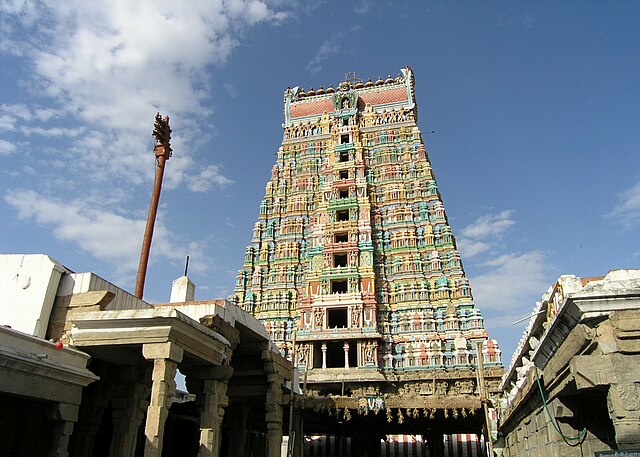
South India has two distinct styles of rock architecture, the Dravidian style of Tamil Nadu, Andhra Pradesh and the Vesara style of Karnataka, Telangana.[339] The Architecture of Kerala is a unique architecture that emerged from the Dravidian architecture in the southwestern part of India.[340]
In Dravidian architecture, the temples considered of porches or Mantapas preceding the door leading to the sanctum, Gate-pyramids or Gopurams in quadrangular enclosures that surround the temple and Pillared halls used for many purposes and are the invariable accompaniments of these temples. Besides these, a South Indian temple usually has a tank called the Kalyani or Pushkarni.[341] The Gopuram is a monumental tower, usually ornate at the entrance of the temple forms a prominent feature of Koils and Hindu temples of the Dravidian style.[342] They are topped by the kalasam, a bulbous stone finial and function as gateways through the walls that surround the temple complex.[343] The gopuram's origins can be traced back to the Pallavas who built the group of monuments in Mahabalipuram and Kanchipuram.[344] The Cholas later expanded the same and by the Pandya rule in twelfth century, these gateways became a dominant feature of a temple's outer appearance.[345][346] Vimanam are similar structures built over the garbhagriha or inner sanctum of the temple but are usually smaller than the gopurams in the Dravidian architecture with a few exceptions including the Brihadisvara Temple in Thanjavur.[347][348]
Vesara style of architecture originated during the reign of Chalukyas and later adopted by Western Chalukyas and Hoysalas.[349] The later Vijayanagara architecture incorporated the features of both Dravidian and Vesara styles.[350] The temples at Mahabalipuram,[344] Thanjavur, Gangaikonda Cholapuram and Darasuram,[351] Hampi[352] and Pattadakal[353] are declared UNESCO World Heritage sites.
Visual arts
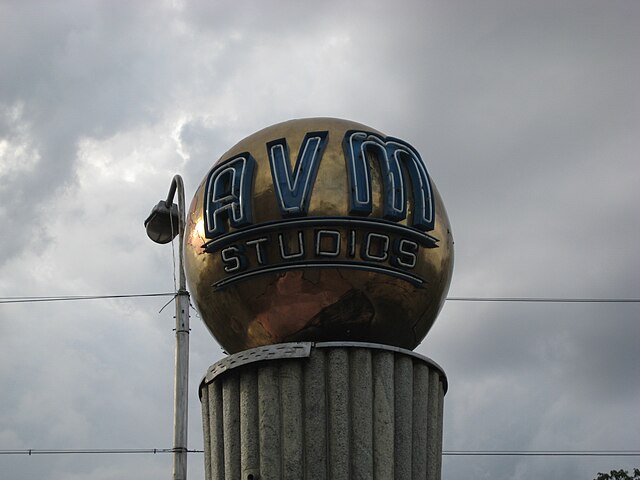
Films done in regional languages are prevalent in South India, with several regional cinemas being recognized: Kannada cinema (Karnataka), Malayalam cinema (Kerala), Tamil cinema (Tamil Nadu), and Telugu cinema (Andhra Pradesh and Telangana). The first silent film in South India, Keechaka Vadham, was made by R. Nataraja Mudaliar in 1916.[354] Mudaliar also established Madras's first film studio.[355] The first Tamil talkie, Kalidas, was released on 31 October 1931, barely seven months after India's first talking picture, Alam Ara.[356]
Swamikannu Vincent built the first cinema studio of South India, at Coimbatore, introducing the "tent cinema", which he first established in Madras and which was known as "Edison's Grand Cinemamegaphone".[357] Filmmakers K. N. T. Sastry and B. Narsing Rao in Telugu cinema; K Balachandar, Balu Mahendra, Bharathiraaja, and Mani Ratnam in Tamil cinema; Adoor Gopalakrishnan, Shaji N. Karun, John Abraham, and G. Aravindan in Malayalam cinema; and Girish Kasaravalli, Girish Karnad and P. Sheshadri in Kannada cinema produced realistic cinema in parallel with each other throughout the 1970s.[358]
South Indian cinema has also had an influence on politics of Tamil Nadu.[359] Prominent film personalities such as C N Annadurai, M G Ramachandran, M Karunanidhi, N. T. Rama Rao, and Jayalalithaa have become chief ministers of South Indian states.[360] As of 2014, South Indian film industries contribute to 53% of the total films produced in India.[361]
Remove ads
Utility services
Summarize
Perspective
Health

All South Indian states rank in the top 10 in institutional delivery in India[363] and life expectancy.[137] South India also rates higher in maternal health and reduction infant and child mortality.[143] Chennai attracts about 45 percent of health tourists and is known as India's health capital.[364]
The number of public facilities in South India as of 2018:
The number of Government Hospitals and Beds in Rural & Urban Areas as of 2017:[365]
Education
Summarize
Perspective
As per the 2011 census, the average literacy rate in South India is approximately 80%, considerably higher than the Indian national average of 74%, with Kerala having the highest literacy rate of 93.91%.[116] South India is home to some of the nation's largest and most prominent public and private institutions of higher education.
Major Educational Institutions
University of Madras, one of the oldest and premier university
IIM Bangalore, one of the top ranked management institutes
IIT Madras, one of the oldest and prominent IITs
IISc Bangalore, one of the premium research institutes
The table below is correct as of 26 November 2022[update].
Following are the Institutes of National Importance present across the region.[366]
Remove ads
Sports
Summarize
Perspective

Cricket is the most popular sport in South India.[367] The region has five current international cricket venues: M. A. Chidambaram Stadium in Chennai, M. Chinnaswamy Stadium in Bangalore, Dr. Y. S. Rajasekhara Reddy International Cricket Stadium in Vishakapatnam, Rajiv Gandhi International Cricket Stadium in Hyderabad and Greenfield International Stadium in Thiruvananthapuram. Six more defunct venues have also hosted international matches in the past.[368][369] Tennis ball cricket is played throughout the region.[370] Indian Premier League is the premium T20 cricket competition which has three teams from the region namely Chennai Super Kings, Royal Challengers Bangalore and Sunrisers Hyderabad. Chennai Super Kings is the most successful franchise in IPL.[371]

Football is also popular with the Indian Super League being the major club competition. There are four teams from the region:Bengaluru FC, Chennaiyin FC, Hyderabad FC and Kerala Blasters FC. The Southern Derby or Southern Rivalry, is the name given to a derby contested by any two of the three professional football clubs Bengaluru, Chennaiyin and Kerala Blasters.[372][373][374] Santosh Trophy is a football competition amongst states organized by the Indian Football Association.[375][376] As of 2022, South Indian teams have won 17 championships.[377]
Kabaddi is a contact sport which is the state game of all the states in South India.[378] It is played across the region. Pro Kabaddi League is the most popular region based franchise tournament and has three teams representing the region: Bengaluru Bulls, Tamil Thalaivas and Telugu Titans.[379][380]
Chess is a popular board game which originated as Sathurangam in the seventh century A.D.[381] Traditional games like Pallanguzhi,[382] Uriyadi,[383] Gillidanda,[384] Dhaayam[385] are played across the region. Jallikattu,[386] Rekla[387] and Kambala[388] are traditional sporting events involving bulls. Traditional martial arts include Silambattam,[389] Gatta gusthi,[390] Adimurai[391] and Kalari.[392] Vallam kali is a boat race organized in Kerala.[393]
See also
References
External links
Wikiwand - on
Seamless Wikipedia browsing. On steroids.
Remove ads













